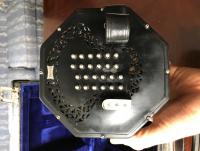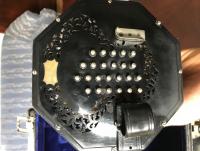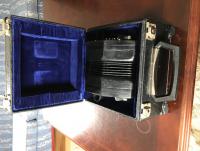Search the Community
Showing results for tags 'ebony'.
-
Yesterday, I heard on the radio, a passing reference to lignum vitae, supposedly the hardest known wood. It set me wondering if such extremely hard woods were ever used to fabricate concertina buttons? You can add ebony to that list, I suppose. I've found one reference to lignum vitae buttons, and a couple of references to ebony in 'historical' threads here, but as far as I can see, the lignum vitae usage was a one-off, and no-one has come clean and actually admitted to using ebony... Any expert out there know if these very hard woods were ever used in any quantity for buttons? Thank you. Roger
- 14 replies
-
Unique Wheatstone Aeola 48 button Pre-WWI English Concertina in the Key of C Treble range (from G below middle C, to C three octaves above middle C). Falling within the "dear years" and "lost years" period of the Wheatstone company, this Ebony ended concertina has unique fretwork detail, and has a full rich tone. The instrument shows only very minor cosmetic blemishes and is in superior playing condition. The bellows are in excellent shape and all buttons are responsive. Concertina was completely looked over and serviced by the Button Box in 2013. Instrument was part of the collection at Barleycorn Concertinas until 2010, at which time it was imported to the United States. For a demo of the instrument, see the following YouTube video: https://youtu.be/DgymVJ-buSo Available for Skype calls for interested parties. $3600
- 1 reply
-
- Wheatstone
- Aeoloa
-
(and 8 more)
Tagged with:
-
After several years' absence, I find myself once again in the concertina world. I've come into possession of a 90 year old Wheatstone model 6 with raised ebony ends. The ends, apart from some light fingernail gouging, are close to pristine. I'd like to keep them that way. For the first 70 plus years of its life the concertina resided in the UK, and then more lately in western Oregon, USA, where it experienced a similar climate. Now I have it in Alaska, which is obviously a harsher world than it has known. (There's a tremendous swing in humidity from summer to winter and back.) I know some flute makers who insist that ebony simply doesn't absorb or lose moisture like other woods, but I have also seen some wooden ended concertinas that where the grill work was pretty busted up. I'd like to avoid that. Does anyone have any advice on caring for the ebony ends? Particularly useful would be anyone living in Norway or northern Scotland, but I'd appreciate any relevant opinion. The grill work seems sooo delicate! Thanks, George Knight Anchorage, Alaska, USA
- 14 replies
-
- Wheatstone
- Ebony
-
(and 2 more)
Tagged with:




